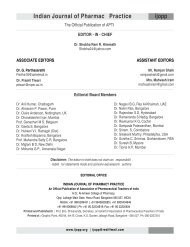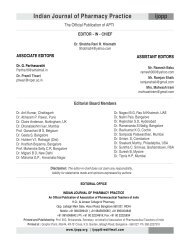APTI ijopp - Indian Journal of Pharmacy Practice
APTI ijopp - Indian Journal of Pharmacy Practice
APTI ijopp - Indian Journal of Pharmacy Practice
- No tags were found...
Create successful ePaper yourself
Turn your PDF publications into a flip-book with our unique Google optimized e-Paper software.
<strong>Indian</strong> J. Pharm. Pract. 1(2), Jan-Mar, 2009tertiary care teaching hospital providing specializedhealth care services. Ethical clearance was obtained fromthe Institutional review board, St. Martha's Hospital, andan Informed consent was taken from the patients beforestarting the study. The period <strong>of</strong> study was 8 months. Alladult and geriatric hospitalized patients <strong>of</strong> medicinedepartment who were diagnosed with lower respiratorytract infection being prescribed with combination <strong>of</strong>azithromycin and cephalosporin during the study periodand who were willing to participate in the study wereincluded. Out patients, Pregnant/lactating patients,Pediatric patients, Non consenting patients werecategorized under exclusion group.In this prospective study, data was collected from casesheets <strong>of</strong> in-patients diagnosed with LRTI. A detaileddescription <strong>of</strong> demographic details, Presentingcomplaints, Past History, Personal History, FamilyHistory, Drug history, Laboratory parameters was taken.Patient follow up was carried out until discharge.Efficacy was determined based upon the clinicalresponse i.e. reduction in the symptoms such as sputumproduction, cough, wheezing, dyspnoea, fever,discolored sputum and length <strong>of</strong> hospital stay. Thepatients were monitored throughout till discharge and thesymptoms were noted at regular intervals <strong>of</strong> three days.The patients were also monitored for any adverse drugreactions during the treatment.Table No.1Gender n %MaleFemale52Table No.25936 41Age n %20-29 4 530-39 16 1840-49 19 2250-59 29 3360-69 10 11= 70 10 11Cost <strong>of</strong> treatment was calculated by “cost effectiveanalysis”. It is an economic evaluation method <strong>of</strong>pharmacoeconomics where cost is measured in monetaryterms and consequences are measured in non-monetaryunits. Cost effective analysis is used when there is singlemeasurable dimension <strong>of</strong> effectiveness for bothtreatments. This method is used when it is necessary tomeasure both cost and clinical outcomes <strong>of</strong> drugs.The cost effective ratio for each treatment option iscalculated. This ratio is total cost <strong>of</strong> the drug divided bythe number <strong>of</strong> units <strong>of</strong> output (benefit). In this case, theoutput is reduction in the symptoms on the seventh day <strong>of</strong>the treatment. Preferred drug is the one with lower costper unit <strong>of</strong> output or health improvement. The differencein the reduction <strong>of</strong> symptoms in different treatmentgroups was statistically analyzed by Chi- square test.RESULTSAfter appropriate scrutiny 88 patients met the inclusioncriteria and were enrolled for the study during a period <strong>of</strong>July 2007 to February 2008. Among the 88 patients thatwere included, 52 (41%) were male and 36 (59%) werefemale. The range <strong>of</strong> age <strong>of</strong> patients was between 23 to 88years. Maximum number <strong>of</strong> patients 29 (33%) were in theage group <strong>of</strong> 50-59 years, depicted in table nos 1 & 2.Patients were addicted to different habits such assmoking, alcohol and tobacco which affect the state <strong>of</strong>disease. Smoking was found to be the commonest amongall the patients who accounted for 51.14% followed bytobacco 29.55% and alcohol consumption 26.13%.Different LRTI diagnosed are given in table no.3 <strong>of</strong>which pneumonia was the form <strong>of</strong> illness in 40% <strong>of</strong>patients making it highest among others.DiagnosisPneumoniaTable No.3Co-Morbid conditions were accounted for the use <strong>of</strong>different combinations <strong>of</strong> antibiotics, <strong>of</strong> whichhypertension was the most common followed byDiabetes Mellitus. Table no.4 gives the details <strong>of</strong> thedifferent combinations used for different co-morbidities.n35AECOPD 20AEBA 13BRONCHITIS 20%4023142354
















